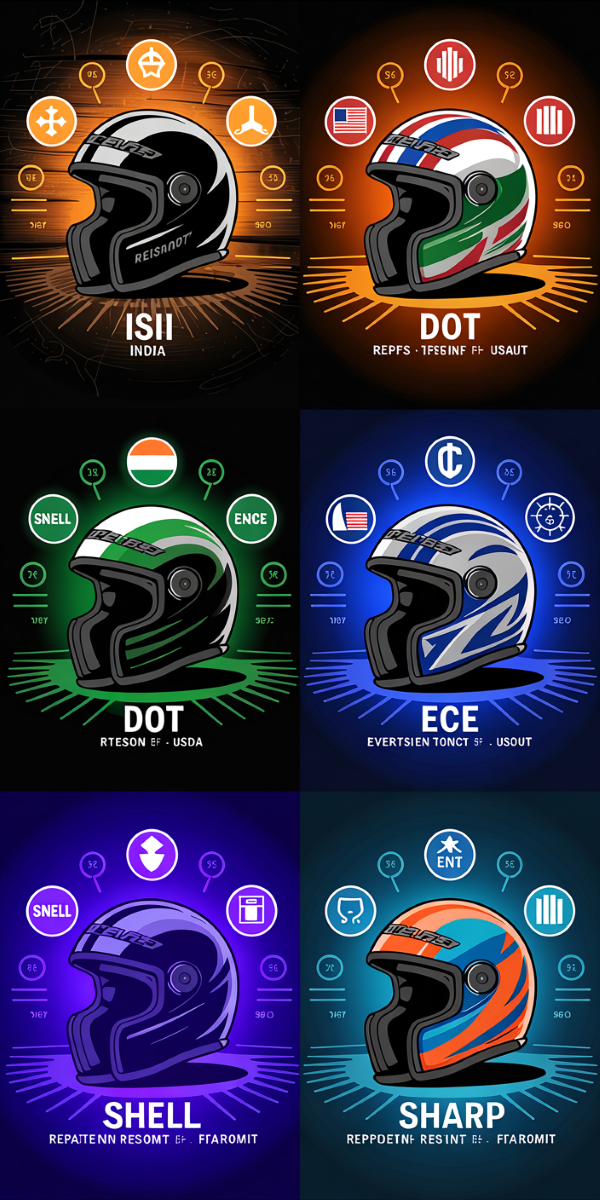Let’s be real-choosing a motorcycle helmet isn’t just about picking the coolest design or the lightest shell. The real game-changer is what’s stamped (or not stamped) on the back: the safety certification. If you’ve ever wondered what those mysterious codes- ISI, DOT, ECE, SNELL, SHARP- actually mean, you’re not alone. This Guide to Helmet Safety Certifications is here to break it all down, so you can ride with confidence and peace of mind.
Why Helmet Safety Certifications Matter
A helmet is your most important riding gear. But not all helmets are created equal. Safety certifications guarantee that your helmet has passed rigorous tests for impact absorption, penetration resistance, retention system strength and more. In India, wearing a certified helmet isn’t just smart-it’s the law. Riding with uncertified or fake helmets can put your life at risk and land you in legal trouble. If you're wondering how to identify fake helmet certifications, always inspect for clear, correct markings and valid documentation.
The Big Five: Key Helmet Safety Certifications
1. ISI (Indian Standards Institute/BIS) – IS:4151
-
What it is: The mandatory certification for helmets sold in India, regulated by the Bureau of Indian Standards (BIS).
-
What it tests: Impact resistance, penetration resistance, retention system and peripheral vision.
-
Why it matters: Only ISI-certified helmets are legal in India. Look for the ISI mark and check for a clear, untampered code on the inside or back of the helmet.
-
Pro Tip: BIS conducts spot checks to ensure ongoing compliance, but always buy from trusted sellers to avoid fakes.
2. DOT (Department of Transportation) – FMVSS 218
-
What it is: The US government’s standard for motorcycle helmets, set by the National Highway Traffic Safety Administration (NHTSA).
-
What it tests: Impact absorption, penetration, retention system and field of vision.
-
Why it matters: DOT-certified helmets are legal in the US and recognised for their safety. Some imported helmets in India carry DOT certification, but ISI is still required for legal road use.
3. ECE (Economic Commission for Europe) – ECE 22.05/22.06
-
What it is: Europe’s most widely recognised helmet standard, accepted in over 50 countries.
-
What it tests: Impact, abrasion resistance, strap strength, deformation and more. Testing is done in independent labs with random samples.
-
Why it matters: ECE-certified helmets are known for rigorous, up-to-date testing and are popular among touring and adventure riders in India.
4. SNELL Memorial Foundation (M2020, etc.)
-
What it is: An independent US-based non-profit that sets some of the world’s toughest helmet standards.
-
What it tests: Multiple impact points, high and low velocity impacts, shell and visor strength and emergency removal features.
-
Why it matters: SNELL certification is voluntary but highly respected, especially among racers and track riders.
5. SHARP (Safety Helmet Assessment and Rating Programme)
-
What it is: A UK government program that rates helmets on a five-star scale, going beyond pass/fail.
-
What it tests: Multiple impact points, energy absorption and real-world crash scenarios.
-
Why it matters: SHARP ratings help you compare helmet safety performance at a glance, but this rating is in addition to, not a replacement for, legal certifications. If you're doing a helmet safety standard comparison, SHARP gives a visual performance rating.
How to Check If Your Helmet Is Certified
-
Look for the mark: ISI, DOT, ECE, SNELL or SHARP should be clearly marked on the helmet.
-
Check the code: For ISI, look for a valid IS:4151 code. For ECE, it’s usually ECE 22.05 or 22.06.
-
Inspect for tampering: Fake helmets may have blurry, misplaced or misspelled certification marks.
-
Ask for documentation: Genuine helmets come with user manuals and certification details.
Which Certification Is Best for Indian Riders?
For legal road use in India, ISI certification is mandatory. However, helmets with dual certifications (like ISI+ECE or ISI+DOT) offer extra peace of mind, especially if you’re into touring, racing or off-roading. If you’re looking for the best helmet certification for Indian roads, prioritise fit, comfort and at least one recognised safety certification.
Why You Should Never Compromise on Certification
-
Safety: Certified helmets are tested for real-world crash scenarios and offer proven protection.
-
Legal compliance: Avoid fines and legal hassles by wearing an ISI-certified helmet.
-
Insurance: Some insurance claims may be denied if you weren’t wearing a certified helmet during an accident.
-
Resale value: Certified helmets hold their value better and are easier to sell or trade.
Final Tips for Buying a Certified Helmet
-
Buy from trusted retailers: Avoid roadside stalls and unknown online sellers. Explore ReiseMoto’s range of ISI-, DOT- and ECE-certified helmets, including premium MT Helmets—engineered for Indian roads and global standards.
-
Check for fit and comfort: Even the safest helmet won’t protect you if it doesn’t fit right. Read our guide to motorcycle helmet fitting here
-
Replace after a crash: Even a certified helmet can only protect you once. Replace it after any significant impact.
Still have questions about helmet safety certifications? Drop a comment or reach out to the ReiseMoto team-we’re here to help you ride safer and smarter, every day!
-Team Reisemoto

